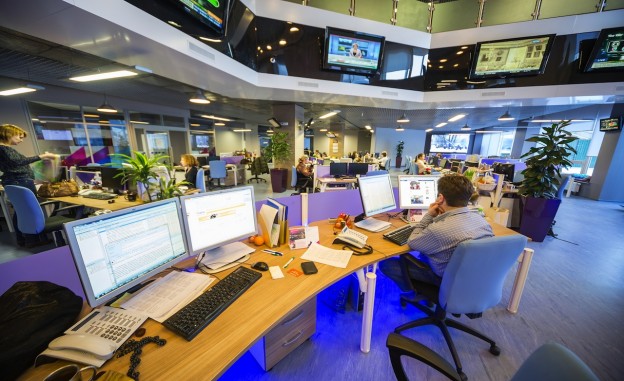Two new reports released recently by the American Press Institute dissect and discuss the best practices for innovation within news organizations and ways to institute a “culture-based strategy” to create and encourage innovation.
But what exactly is “innovation?” The definition has become a very loose one within the journalism community.
“I think most legacy news operations think that innovation is doing something new that they haven’t done before. And that is part of it,” said Tom Rosenthiel, executive director at the American Press Institute.
Yet innovation isn’t just about technology and tools, he said. The more meaningful innovation encompasses thinking in new ways about connecting and engaging with audiences, and likely means changing the culture of the organization.
‘You start with an assessment of the ecology of the culture’

A photo of the BBC Newsroom in June 2013. Photo by Flickr user just1snap and reused here with Creative Commons license.
Journalist Craig Silverman, editor at BuzzFeed Canada, authored the report on the best practices taking place in newsrooms. He wrote that for the purpose of the study, “innovation” is defined as “the process of bringing new practices, culture, and products alive within an organization.”
In other words, it’s about how an organization works and moves forward.
The first step media organizations must make when trying to encourage innovation, Rosenthiel said, is to understand the people of the organization because they’re the ones who are going to have to implement the change. It’s an almost anthropological approach that’s necessary — “an assessment of the ecology of the culture,” he said. This would also be the logical intervention when resistance to changes and ideas occur.
“The way you can make systemic change is that you first have to do an assessment and see, ‘Who are the people who want to change and are ready to change?’ Rosenthiel told MediaShift. “You need to identify what gets in the way of their succeeding. You need to figure out what reactions some of the more fearful staff have.”
The former group of willing change-makers can serve as role models, for example, whereas the latter group of individuals who may be more resistant to change are still crucial to understand for their own skill and “institutional memory.”
This sort of deep assessment of the individuals within the newsroom and other departments within a media organization, such as advertising and circulation desks, is largely based on empathy. Understanding where everyone is coming from is crucial for everyone to eventually be on the same page. This applies to freelancers as well, since they have to know where an organization stands to best strategize how to make an offer to that particular organization.
“In the case of freelancers, you have to develop an empathy for the organizations you’re pitching,” Rosenthiel said. “Successful freelancers intuit the organizations they work for.”
Balancing the tribes

Office of The Cornell Daily Sun in Ithaca, New York, in March 2009. Photo by Matt Hintsa and reused here with Creative Commons license.
Understanding a media organization’s culture is one thing. But so too is understanding the “tribes” within that culture — the different groups that identify and affiliate with each other, whether they be young reporters, veteran journalists, data people, graphic designers, and so forth.
“You want to protect the tribes,” Rosenthiel said. “But you also want to create more communication among different tribes.”
More communication could stem from rearranging the newsroom so that different tribes sit next to each other or having people from different tribes sit in on the same meetings, for example; there is no one exact way to encourage this. The ultimate goal, though, is to create new tribes from the people of the different tribes, like venn diagrams that intersect.
“The recognition here is the tribalism is a positive, and you need to balance the positive influence of that to create new communications,” he said.
More insights on the reports’ findings are online here and here.
Sonia Paul is a freelance journalist based in India, and is the editorial assistant at PBS MediaShift. She is on Twitter @sonipaul.

